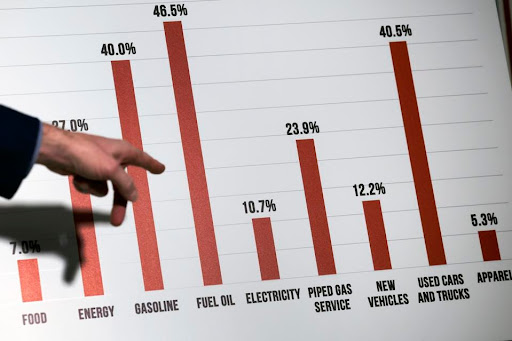Fight Inflationary Pressures with IT Cost Optimization Strategies
Inflation and slowed business growth are creating pressure for deeper strategic cost optimization. Business leaders the world over are asking tough questions such as:
-
How do I save money?
-
How do I pay for new initiatives on a tighter budget?
-
Do I have to lay off some of my staff, or is there a better way?
Before we answer what you can do to optimize your IT in a way that cuts costs significantly, let’s first take a deeper dive into the current state and near-future of our economic situation.
A Broad Look at Our Economy

Are we in a recession? Most people say yes, a few say “not quite yet,” and everyone agrees on one thing – prices on anything and everything have gone up. Inflation may have begun to slowly loosen its grip from the peak in June and July 2022, but it’s still high enough to wreck the ability of many companies to pay for their overhead. In fact, price growth is so fierce that the federal government is willing to raise interest rates, increase unemployment, and slow the economy even further to get prices under control. That’s not an immediate fix, though. This means your company has to deal with inflationary pressure for the foreseeable future.
Many businesses have now begun to lay off workers. In the US last year, job cuts rose with a 6% increase for the first 11 months when compared to 2021. Many companies made layoffs in December, so that number is surely higher once the last month of 2022 is factored in.
The technology industry has seen a particularly high number of layoffs, as numerous high-profile tech companies, including Meta, Twitter, and Amazon, each announced mass layoffs. When things are more expensive, less people buy products they don’t need. For businesses, this means less money is coming in at the same time more money is going out to cover expenses.
Don’t expect anything to change any time soon. Inflation is slowly and steadily coming back down, but if you’re trying to make your budget, looking too far into 2023 isn’t going to help.
Is There a Better Way to Deal with Inflationary Pressure?

Surely, there is a way to cut expenses during a tough economic time without laying off the people who depend on you.
Layoffs may not even be an effective strategy anyway. Stanford Graduate School of Business Prof Jeffrey Pfeffer says, “Layoffs often do not cut costs, as there are many instances of laid-off employees being hired back as contractors, with companies paying the contracting firm. Layoffs often do not increase stock prices, in part because layoffs can signal that a company is having difficulty. Layoffs do not increase productivity. Layoffs do not solve what is often the underlying problem, which is often an ineffective strategy, a loss of market share, or too little revenue. Layoffs are basically a bad decision.”
So the question becomes – what is a good decision? What is the right way to deal with tightening your belt?
Telecom Expense Management “TEM” Touches Multiple Cost Optimization Opportunities for IT
Your IT department is ripe with cost optimization possibilities. One we encourage you to pay special attention to is the concept of Telecom Expense Management (TEM). TEM refers to managing your communication services to better control your total costs. It is dedicated to understanding, managing, and reducing your enterprise’s communications spend. It makes it possible to track, control, and identify potential overspend proactively, and then facilitate a chargeback. By implementing a TEM, you can cut costs in a number of different ways. Let’s look at just a few of them.
Removing or Replacing Low-Usage, Underserving Features or Services
Integrate your enterprise data with vendor data to maintain a real-time understanding of spend across vendors, locations, and business units. Where are you spending money? Where could this be reduced in order to reuse the money saved elsewhere?
More than likely, your business is spending money on technology services and software features that aren’t being used, or not being used enough to justify paying for them. A TEM strategy will first begin by using metrics for service usage, adoption, and cost. Then, the lines that are not being utilized will be identified and wasteful spending will be removed.
Reduce Carrier Surcharges
USF, UCC, and other pseudo charges can be minimized. USF is assessed by USAC, a group at the FCC, on interstate, international and to a lesser degree VoIP and mobile services. Telecom vendors impose additional surcharges to the USF that give the impression they are taxes, with names such as Property Tax Allotment and USF admin fees. The PTA charges vary by vendor as do the USF admin fees. The FCC allows telecom vendors to charge for this and enterprises often see 7 or more associated line items on their invoices. There is a wide interpretation by vendor on which services the fees apply to. These charges do not show up in fixed fees and are going up dramatically. On certain domestic charges, these fees can reach over 50% of the total. It is critical to have suppliers outline their carrier surcharge fees for you. You should also set a strategy and get expert help to reduce them as much as possible.
Facilitating a Network Transformation
If you’re still running your network the way you did 20 years ago, your costs are only going to get higher and your processes are only going to get less efficient.
New Internet networking technologies (SDWAN), as well as Unified Communication as a Service (UCaaS), are being adopted a world over by leading enterprises. This could mean replacing old-fashioned conference call lines with Zoom or Microsoft Teams, which is not only less costly but also provides a better experience. A focus on TEM means you are able to analyze what network services you have today and what you can move to, as well as what costs you could be enjoying in the future.
Identifying Vendor Contracts Eligible for Competitive Bidding
How much do you pay for your company’s internet and phone plans? Companies hold more power when negotiating their telecom contracts than many people realize. Enterprises spend as much as 50% of their IT budgets with network service providers (NSPs), yet don’t know this can be lowered. In fact, adopting a competitive bidding strategy will allow you to reduce carrier spending by as much as 20%.
While it is true that network contracts are typically multiyear, they can usually be renegotiated on an annual basis in exchange for extending the contract, like for another year. It’s certainly worth a try, especially if you have a skilled and experienced negotiator working on your behalf who has successfully handled these types of contract conversations in the past.
Reducing Network Operations Costs (Labor) By Embracing Automation of Invoicing
Reducing manual labor costs via automation is a fantastic way to enable your organization to free up resources for other expenses. TEM makes it possible to automate invoice processing completely – from invoice receipt, to allocation, to payment. Modernizing invoice receipts via automation means the collection and validation of global complex telecom and cloud invoices is done with a reduced workforce. Fewer people working on invoicing means a big cut in labor costs associated with this task.
In Summary
Business costs are going up. There is no doubt about that. There is a good way to counter these forces; optimize your IT!
TEM is a fantastic way to get started. And working with Sakon will empower your IT, Finance, and Accounting departments with a purpose-built solution for telecom and cloud services that drives a guaranteed ROI.
As a next step, please read about our suggested 10 low-lift ways to optimize your telecom budget. These can be found in our free guide 10 Ways to Save on Telecom Expenses.
 Blogs
,
Cost Optimization
Blogs
,
Cost Optimization

